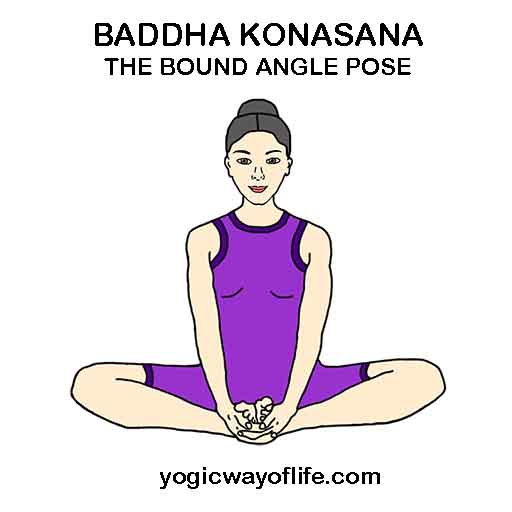Baddha Konasana or Bound Angle Pose improves flexibility of the muscles of the inner thighs, hips and the groins. In Sanskrit, Baddha means bound, Kona means angle and Asana means a pose. Some call this pose the Cobbler’s pose. Baddha Konasana can be practiced as a preliminary pose to create flexibility of the groins, hips and legs. This flexibility will help one to sit in meditative postures for a long duration.

How to do Baddha Konasana (Bound Angle Pose)?
- Sit on the floor with legs stretched out.
- Bend the knees and bring the feet together.
- Hold the ankles with the hands and pull it towards the groins.
- Wrap your interlaced fingers around the feet and hold it.
- Pull the feet towards you as much as possible. Do not strain.
- Try to keep the knees as close to the ground as possible, but do not force it.
- Keep the chest open and the back straight. Relax the arms and shoulders and gaze straight ahead. Breathe slowly and steadily with awareness.
- Hold the position for as long as you are comfortable.
- To release the position, free the hands and stretch the legs in front of you. Gently massage the thighs and groin muscles if there is any pain and if needed, lie in Shavasana as a relaxation pose.
- The knees can also be moved up and down in the final position, also popularly known as the butterfly pose and is used to loosen the groin and hip muscles.
Benefits of Baddha Konasana (Bound Angle Pose)
- Baddha Konasana improves the flexibility of the groin muscles, the hips and the thighs.
- This pose is good for preparation to sit in other meditative postures like the lotus pose or Padmasana.
- Helps to open up the pelvic region and can alleviate sciatica.
- It can relieve hernia and pain in the testicles.
- It can help women to regulate their menstrual cycle.
Contraindications of Baddha Konasana
- Baddha Konasana should not be done by those suffering from any groin, hip or knee injury.
- Women should avoid this during their menstruation.
- If the knees do not touch the floor, do not push it down forcefully beyond a limit. The performance of any asana should be without pain.
- Those with high blood pressure and heart problems should do this with caution with guidance from an authorized yoga instructor.
